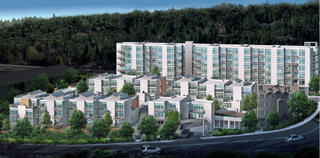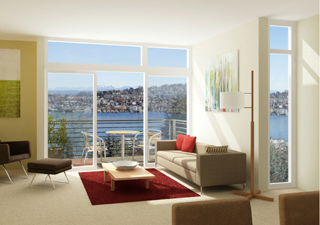
DJC.COM
July 26, 2007
Neglected property does an about-face
Intracorp Seattle

Armstrong
|
The site, just south of Canlis restaurant on the east side of Aurora, was a challenging one. The parcel under the motel was a tiny sliver fronting Aurora, 340 feet long but less than 50 feet wide and zoned for a 65-foot height. A second parcel to the east, also deeded to the motel owners, was zoned L3 and occupied by an odd assortment of buildings built haphazardly between the 1940s and the 1970s. A narrow right of way of limited use separated the two parcels, and served mainly as a motel parking lot.
Big challenges, opportunities
Intracorp’s land acquisition team recognized the development challenges, but also opportunities to transform the site into something spectacular. On the backside of the motel, a commanding view across Lake Union rivaled the legendary panorama from Canlis. The eastern parcel terraced toward the lake, affording additional views. And there was much more to the access than the Aurora frontage. Dexter and Sixth avenues delivered easy access to Queen Anne and the west side of Lake Union. Most surprisingly, Fremont was only a 10-minute walk.
Intracorp is partnering with Mithun, which is the project’s architect, landscape architect and interior designer. From the partnership emerged a completely new vision for the property — a 92-unit condominium project of lofts and townhomes called Domaine.
Turning its back on the past

Images courtesy of Intracorp Seattle Busy Aurora Avenue hides behind Domaine’s mid-rise building, largely out of sight and mind for residents.
|
The design for Domaine effectively “turns its back on the past” by shifting the entire focus of the project away from Aurora and towards Lake Union. Taking advantage of the zoning designation, the former motel site supports a six-story mid-rise with views of Lake Union, Gasworks Park and the Cascades. On the Aurora-facing side, a single-loaded corridor perfectly suited to the narrow lot handles unit access. It reinforces the east-facing orientation and also creates a double wall between the units and Aurora, serving as a noise buffer.
On the L3-zoned parcel, townhomes oriented toward the lake and terraced down the hillside maximize the views. These homes surround a landscaped central courtyard and bocce ball court. Between the two parcels, the narrow right of way is reborn as a tree-lined lane, turning a dusty utilitarian street into a focal point of the project. Pedestrian linkages span the lane, joining the two sections of the project into a unified community. Front porches on the townhomes face the lane.
Neighborhood feel

Condos face away from Aurora Avenue to overlook Lake Union and the Cascades.
|
Domaine demonstrates that by taking a different vantage point on a property, it is possible to find striking development opportunities in unexpected places. The Aurora corridor alongside Queen Anne is a mini-neighborhood, not geographically large and all but undiscovered despite its proximity to a major thoroughfare. It offers the access and convenience of a close-to-downtown in-city location, without sacrificing the feel of a neighborhood community. To preserve that feel, there are large landscaped common spaces throughout the project. Also, most of the homes have generously sized decks while some have private outdoor spaces.
Despite the lakeside orientation, the design does not turn its back on Aurora completely. The six-story façade facing the street combines metal panels with clear and translucent glass, enclosing the corridor. This creates a backlit structure with an interesting interplay between light and dark, shades of color and translucency that serves as a landmark for drivers passing by.
A full-height lit stairwell on the north side of the mid-rise was of special interest to the design review board. It serves as a beacon for drivers approaching from the north as they cross the Aurora Bridge and pass by Canlis. From every vantage point, it’s a major transformation for the neighborhood. And quite a departure from the old motel.
Kathryn Armstrong joined Intracorp Seattle in 1997. She leads the firm’s high-rise and urban mixed-use developments.
Other Stories:
- Is condemnation in your business plan?
- Creating diverse housing in South Lake Union
- Urban canyons are making cities grand
- Seattle’s urban boundaries push outward
- Our region faces six urban design challenges
- Bellevue loads up on urban projects
- Bellingham gets ready to transform its waterfront
- TOD is key to a successful light-rail system
- South Lake Union prepares for its future
Copyright ©2009 Seattle Daily Journal and DJC.COM.
Comments? Questions? Contact us.